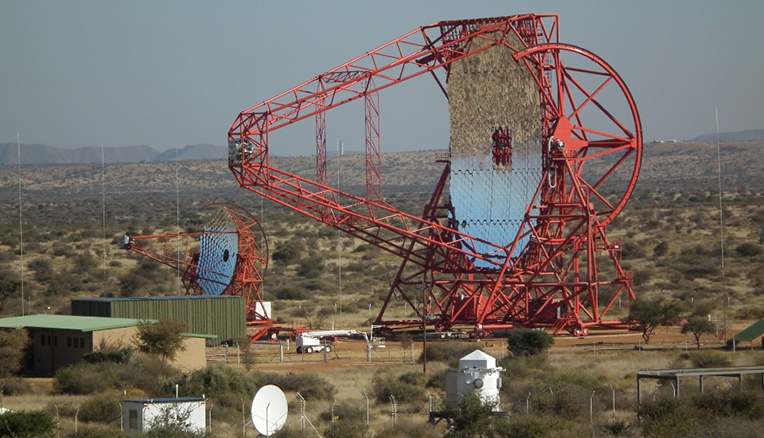Think of an object with a mass exceeding that of the Sun, squeezed into a volume of a sphere with the radius of a city like Bloemfontein. This very dense, compact object, known as a pulsar, is also a great source of energy. According to Physics Professor,
Prof Pieter Meintjes, this pulsar (neutron star produced in supernova explosion) is also a key element of a recently submitted paper in
Nature Astronomy.
Prof Meintjes and
Dr Brian van Soelen, Senior Lecturer, both from the
Department of Physics at the University of the Free State (UFS), were part of the
High Energy Stereoscopic System (H.E.S.S.) collaboration of 220-plus scientists worldwide who worked on the paper Resolving the Crab pulsar wind nebula at tera-electronvolt energies, published in the prestige journal Nature Astronomy.
According to Prof Meintjes, the fact that the paper was accepted for publication in Nature Astronomy testifies of the importance of this finding in the high-energy astrophysics community.
Powerful generators of electricityHe elaborates on the study: “The name pulsar originates from the fact that rotating neutron stars produced in supernova explosions produce beams of radiation, much like a lighthouse. Every time the beam intersects the observer’s line of sight, the observer receives a pulse of radiation.”
“As a result of this enormous mass squeezed into a small volume, these objects have the same density as that of an atomic nucleus. These objects (very dense pulsars) spin very rapidly and have enormous magnetic fields; for example, the pulsar at the centre of the Crab Nebulae spins around its axis once every 33 milliseconds (millisecond: one thousandth of a second) and possesses a magnetic field strength of the order of one tera-Gauss (tera – million x million). For comparison, the average strength of the Earth’s magnetic field is 0.5. Gauss and the magnetic field strength on the Sun ranges between 1 000 and 4 000 Gauss.”
“Because of this very super-strong rapid-spinning magnet, enormous electric fields are induced that can accelerate particles such as electrons and protons to energies in excess of one tera-electronvolt (optical light that are emitted by an ordinary lightbulb has energies of the order of one electronvolt).”
Prof Meintjes continues: “This means that these fast-rotating neutron stars are extraordinary powerful generators of electricity, which fills the surrounding cloud (supernova remnant) with super-high energy-charged particles that can produce, in turn, very high energy gamma rays through various processes such as synchrotron radiation and inverse-Compton radiation, to name a few.”
H.E.S.S. collaboration Above one tera-electronvolt, the gamma rays are detected by huge ground-based telescopes such as H.E.S.S., utilising the Earth’s atmosphere.
“When these high-energy gamma rays enter the atmosphere, they produce showers of super-relativistic particles that produce Cherenkov light – detected by the telescope. The technique is called the Atmospheric Cherenkov Technique (ACT).”
 The High Energy Stereoscopic System. (Photo: Supplied)
The High Energy Stereoscopic System. (Photo: Supplied)
“The H.E.S.S. gamma-ray collaboration is but one collaboration that has studied this source intensively over the past couple of decades or so. Being the most powerful gamma-ray telescope facility currently operational, very careful analysis of the data managed to reveal that the gamma-ray emitting region inside the nebula is about 10 times bigger in size than the region where the x-rays are emitted within the nebula.”
“This has solved a long-standing question as to how big the gamma-ray emitting region within these supernova remnants are, compared to the region where the x-rays, for example, originates,” says Prof Meintjes.
Both Prof Meintjes and Dr Van Soelen are members of this prestigious H.E.S.S. collaboration. Their participation in this project, together with scientists from universities such as the University of Oxford, the University of Leicester, and the University of Bordeaux, opens up valuable research opportunities for UFS postgraduate students to enter the international stage and interact with the best scientists in the world.
They are also members of the editorial board responsible for the internal review of research papers before being submitted to more prestigious journals, for example, Nature Astronomy. Dr Van Soelen is also a coordinator of multi-wavelength follow-up observations within the H.E.S.S. collaboration.
This is the second time that Prof Meintjes published in Nature Astronomy. Previously, he was co-author of a paper on emission from a white dwarf pulsar, showing that fast-rotating white dwarf stars could in fact mimic emission from neutron star pulsars. He developed the theoretical model reported in that paper, explaining the multi-wavelength emission from radio to X-ray energies.